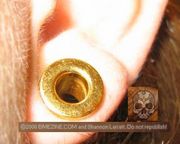Gold: Difference between revisions
Jump to navigation
Jump to search
(Created page with "<html><div class="mw-content-ltr" dir="ltr" id="mw-content-text" lang="en"><div class="thumb tright"><div class="thumbinner" style="width:182px;"><a class="image" href="/index.php?title=File:Bmepb349087.jpg"><img alt="Bmepb349087.jpg" class="thumbimage" height="144" src="/images/thumb/c/ca/Bmepb349087.jpg/180px-Bmepb349087.jpg" width="180"/></a> <div class="thumbcaption"><div class="magnify"><a class="internal" href="/index.php?title=File:Bmepb349087.jpg" title="Enlarge"...") |
(No difference)
|
Revision as of 01:38, 21 May 2023
Gold is a precious metal often used in body jewelry. Pure gold is 24 karats, but the gold used in body jewelry is generally an alloy—a combination of gold and another metal, often copper, silver, nickel, or zinc. For this reason, people who experience sensitivities to other metal jewelry will likely experience the same allergic reactions to gold jewelry. Gold jewelry is generally considered too porous for use in fresh piercings.
